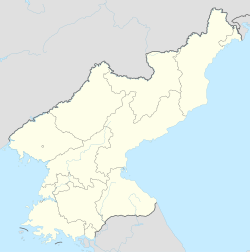
Back Gaeseong ACE كايسونغ Arabic Keson Azerbaijani Кэсон Byelorussian Кесън Bulgarian Kaesong Catalan Kaesŏng CDO Kaesŏng (kapital sa munisipyo sa Amihanang Koreya) CEB Kesong Czech Kaesong Danish
Kaesong
개성시 | |
|---|---|
| Korean transcription(s) | |
| • Chosŏn'gŭl | 개성특별시 |
| • Hanja | 開城特別市 |
| • McCune–Reischauer | Kaesŏng-T'ŭkpyŏlsi |
| • Revised Romanization | Gaeseong-Teukbyeolsi |
Clockwise from top: Koryo Songgyungwan University, Mausoleum of King Kongmin, street in Kaesong, skyline of Kaesong Industrial Region and downtown Kaesong, Sungyang Academy, fall foliage in Kaesong | |
| Nickname(s): "City of Pines" (송도; 松都; Songdo) | |
 Kaesong location within North Korea | |
 | |
| Coordinates: 37°58′N 126°33′E / 37.967°N 126.550°E | |
| Country | North Korea |
| Province | Kaesong |
| Settled | c. 700 |
| Administrative divisions | 24 dong, 3 ri |
| Area | |
| • Total | 179.26 km2 (69.21 sq mi) |
| Population (2009) | |
| • Total | 192,578 |
| • Density | 1,100/km2 (2,800/sq mi) |
| • Dialect | Gyeonggi |
| Time zone | UTC+9 (Pyongyang Time) |
| Other information | Split from Gyeonggi in 1951; joined North Hwanghae in 2003. Left North Hwanghae and became special city in 2019. |
Kaesong[a] (UK: /keɪˈsɒŋ/, US: /keɪˈsɔːŋ/; Korean: [kɛsʌ̹ŋ]) is a special city in the southern part of North Korea (formerly in North Hwanghae Province), and the capital of Korea during the Taebong kingdom and subsequent Goryeo dynasty. The city is near the Kaesong Industrial Region close to the border with South Korea and contains the remains of the Manwoldae palace. Called Songdo while it was the ancient capital of Goryeo, the city prospered as a trade centre that produced Korean ginseng. Kaesong now functions as North Korea's light industry centre.
During the Japanese occupation from 1910 to 1945, the city was known by the Japanese pronunciation of its name, "Kaijō".[2] Between 1945 and 1950, Kaesong was part of South Korea and under its control. During the Korean War, North Korea captured the city, and the 1953 Korean Armistice Agreement left the city under North Korean control. Due to the city's proximity to the border with South Korea, Kaesong has hosted cross-border economic exchanges between the two countries as well as the jointly run Kaesong Industrial Region.
As of 2009, the city had a population of 192,578.[3]
- ^ EB (1878), p. 390.
- ^ Historic Map: Geographic overview Japan & Korea 1945 AD – 1B
- ^ "City population by sex, city and city type". United Nations. 2009. Retrieved 16 December 2013.
Cite error: There are <ref group=lower-alpha> tags or {{efn}} templates on this page, but the references will not show without a {{reflist|group=lower-alpha}} template or {{notelist}} template (see the help page).






